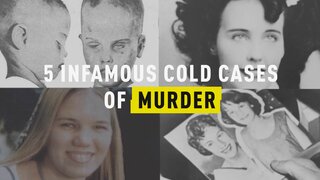Create a free profile to get unlimited access to exclusive videos, breaking news, sweepstakes, and more!
These Washington DC Cold Cases Continue To Baffle Investigators
The murders of a mistress of John F. Kennedy Jr. and a Washington intern allegedly involved in an illicit affair are among some of the most troubling unsolved Washington D.C. cold cases.
On the evening of August 2, 2006, successful, young attorney Robert Wone called his wife to tell her he’d be staying at a friend’s house in Washington D.C. rather than making the late-night trek back home to Oakton, Virginia.
Less than three hours later, Wone would be dead.
His death — and the bizarre circumstances around it — would spark a nearly two decade long unsolved mystery about who could have killed the 32-year-old. The investigation would lead to a baffling set of clues and witnesses.
RELATED: See The Trailer For Peacock's New Docuseries 'Who Killed Robert Wone?'
Wone, who had recently began a new job as the general council for Radio Free Asia, called his wife Kathy around 9:30 p.m. the night of Aug. 2, 2006 to tell her he was headed back into the office to meet the night shift radio disc jockeys at his new workplace, according to The Washingtonian. Rather than make the drive home, Wone told her after the visit he planned to stay with his old college friend Joe Price, who lived in near the city’s famed Dupont Circle.
Price, a prominent gay rights activist, lived at the property with his longtime romantic partner Victor Zaborsky and lover Dylan Ward as part of a three-way relationship. Wone formed a tight friendship with Price while attending the College of William & Mary through their shared interest in student government and community activism.
Those who knew Wone, including his wife, have insisted he was straight and happily married, the paper reports.
Shortly before midnight, someone inside the Swann Street home placed a call to 911 to report that Wone had been stabbed to death. He was found dead by paramedics, laying on his back on a pullout couch in a guest room with three clean stab wounds to the chest.
The three men living at the residence told authorities they had been asleep when an intruder must have broken into the home and killed Wone before stealing off into the night. But there were troubling signs at the scene. One paramedic reported the body looked like it had been “showered, redressed, and place in the bed,” according to the news outlet.
The stab wounds had been almost surgical in nature a medical examiner later stated, suggesting that Wone may have been incapacitated at the time they occurred.
An affidavit later revealed that Wone’s body also had multiple needle marks. A bloody knife — with fibers from a nearby towel — was found bedside the bed.
Despite the abundance of evidence, no one has ever been charged with Wone’s murder, according to the news outlet.
The case continues to plague investigators and is the focus of the upcoming Peacock documentary, “Who Killed Robert Wone?” but it isn’t the only case to baffle Washington D.C. investigators.
Other mysterious cold cases in the nation’s capital include:
Seth Rich
Democratic National Committee staffer Seth Rich was gunned down as he walked home in the early morning hours of July 10, 2016, according to the Metropolitan Police.
The 27-year-old was shot multiple times in the Bloomingdale neighborhood just outside Northwest Washington, D.C. around 4:20 a.m. while he was on the phone with his girlfriend, NBC affiliate WRC-TV reported.
His mom, Mary Rich, told the news outlet that police believed the young Democratic staffer was the latest victim of a string of robberies in the area.
“There had been a struggle,” she said. “His hands were bruised, his knees are bruised, his face is bruised, and yet he had two shots to his back, and yet they never took anything.”
It didn’t take long for rumors about his death to begin to swirl.
Far-right conservatives ran stories suggesting that Rich had leaked Democratic National Committee (DNC) emails to Wikileaks and was killed as retribution, despite any substantial evidence to support the allegations, CNN reported. The theory sprouted up around the same time President Donald Trump was disputing reports that Russia had really been behind the hack.
Special Counsel Robert Mueller delved into the allegations as part of an investigation into Russia’s activities during the 2016 election. His report discredited the theory of Rich’s involvement and determined that Russian military intelligence officers had been talking with Wikileaks about the leaked DNC documents before Rich’s death, according to CNN.
His parents later settled a lawsuit against Fox News for promoting what the suit described as a “sham” story about their son. Rich’s brother also reached a settlement with businessman Ed Butowsky and internet activist Matt Couch for their involvement in promoting the unfounded theory. Both later issued public apologies retracting their comments.
“Today we retract and disavow our statements and we offer our apology to Mr. Rich and his family,” Coach said, according to CNN. “I take full responsibility for my actions … and would like to apologize to Mr. Rich and his family.”
Rich’s murder remains unsolved.
“The Freeway Phantom” Killings
For more than a year in the early 1970s, young Black girls were disappearing from the neighborhoods of Washington DC.
Between April 1971 and September 1972, Metropolitan Police said six Black girls — ranging in age from 10 to 18 — were abducted and killed by a suspect ominously dubbed “The Freeway Phantom.”
As the killings increased, the killer got more brazen, calling one victim’s family to tell them he’d killed their daughter and leaving a note on the body of another taunting police, “Catch me if you can!”
The first victim, Carol Spinks, was abducted on her way home from the 7-11, according to The Washington Post. Her body was found four days later in a grassy area along Interstate 295. She had been sodomized and strangled to death. Investigators believe her killer had likely kept her alive for days before killing her.
Ten weeks later, the body of a second victim, 16-year-old Darlenia Johnson, was found by a D.C. Department of Highways and Traffic employee along the same interstate. She disappeared on her way to work at a local recreation center.
Just nine days later, the body of 10-year-old Brenda Faye Crockett was discovered by a hitchhiker off Route 50. She vanished on her way to the grocery store to buy bread and dog food for the family’s pets.
Shortly after she disappeared, Brenda called her family’s home and told her sister through tears that she had been “snatched” up by a white man who was going to send her home in a taxi, according to the news outlet. Her mother had already been out searching for her. Brenda called again 25 minutes later and talked to her mother’s boyfriend, asking, “Did my mother see me?” When the boyfriend asked to speak to her abductor, she quietly said “well, I’ll see you,” before the line went dead.
Nenomoshia Yates, 12, disappeared Oct. 1, 1971 on her way home from the grocery store. Like many of the other victims, she was later found raped and strangled to death.
The next month, 18-year-old Brenda Woodard would vanish after stopping at Ben’s Chili Bowl with a friend and then taking the bus home. She was found raped, strangled and stabbed to death just south of Route 202. A note written in her own handwriting was found in her pocket with a message police believe the killer had forced her to transcribe.
“This is tantamount to my insensititivity [sic] to people especially women. I will admit the others when you catch me if you can!” it read.
It had been signed “Free-way Phantom!”
The serial killer’s sixth and final victim was 17-year-old Diane Williams, who was discovered by a trucker strangled to death off the I-295. Her family later got an eerie call from a man who claimed, “I killed your daughter,” according to The Washington Post.
Over the years, authorities have zeroed in on multiple possible suspects, but never found any evidence to link anyone to the crime. Investigators would later admit that much of the evidence in the cases was lost, keeping the killer’s identity unknown.
Mary Pinchot Meyer
Mary Pinchot Meyer’s death has all the elements of a possible conspiracy. The artist was once married to a CIA official and had been the mistress of President John F. Kennedy before his death.
The president once begged her to visit in note, writing, “why don’t you just say yes,” according to Town & Country Magazine.
The popular 43-year-old socialite was gunned down, shot execution style with a bullet to the head and one to the chest, as she took her regular afternoon stroll along the Chesapeake and Ohio Canal towpath in Georgetown in October 1964. Her death occurred just weeks after the Warren Commission concluded that Kennedy had been assassinated by a lone gunman, a contention she had allegedly challenged before her death, according to the magazine.
In less than an hour, police arrested a Black man named Ray Crump Jr. who was found near the scene. Crump’s clothes were soaking wet and he had a cut on his hand, according to the Smithsonian Magazine. He told police that he had dropped his fishing pole into the water and went into the river to fetch it, getting himself soaked in the process.
But two witnesses told police they saw him standing over the body and his fishing pole was later found at his home. Crump was arrested and went on trial for murder, but was acquitted in 1965 for a lack of evidence.
Decades later, her murder has never been solved.
Chandra Levy
For more than two decades, mystery has continued to surround the death of Chandra Levy, a Washington D.C. intern who disappeared in May 2001.
Levy — a native of California — had moved to the nation’s capital for an internship with the Bureau of Prisons as part of her master’s program in public administration, according to ABC News. It was there the 24-year-old allegedly began an affair with California Congressman Gary Conduit, a married man 28 years her senior.
According to former FBI agent Brad Garrett, who was a lead investigator on the case, Levy “led a very isolated life once she started this relationship with Gary, because they only time[s] she’d really see him were after hours.”
Conduit, who was never named a suspect in her disappearance, has insisted he did not harm her and was not having a romantic relationship with her, according to USA Today.
Shortly before Levy had planned to return home to California, the 24-year-old mysteriously vanished, leaving a fully-packed suitcase behind at her apartment. Her body was found on May 22, 2002 in a remote area of Rock Creek Park.
Washington D.C.’s medical examiner at the time, Dr. Jonathan L. Arden, concluded that Levy’s cause of death could not be determined but noted that “the circumstances of her disappearance and her body on recovery are indicative that she died through the acts of another person,” ABC News reported.
For years, no arrests were made until 2009, when police charged Ingmar Guandique, a man convicted of attacking two women in Rock Creek Park around the same time Levy disappeared, with the murder.
He was convicted and sentenced to 60 years in prison during a trial that relied heavily on the testimony of his cellmate, Armando Morales, who testified that Guandique had confessed to killing Levy.
Guandique continued to maintain his innocence, telling ABC News he “never had any contact” with Levy and the conviction was overturned in 2015 after concerns about the cellmate’s credibility.
Prosecutors believed they could no longer prove the case against Guandique without a reasonable doubt and opted not to retry the case, WRC-TV reports.
Guandique, who U.S. Immigration and Customs Enforcement officials said was a documented member of the MS-13 gang, was deported to El Salvador in 2017.
“Mr. Guandique unlawfully entered the United States, and once here, continued to violate U.S. laws by assaulting innocent victims,” ICE official Matthew Munroe said at the time. “As a result of his actions, he has been removed to his home country of El Salvador.”
Levy’s case remains unsolved.
Raymond Nels Nelson
Beloved Capitol Hill staffer Raymond Nels Nelson was found brutally beaten to death in his Washington D.C. apartment by his roommate on June 1, 1981, according to The Washington Post.
The 59-year-old had spent 13 years working as an administrative assistant for Senator Clairborne Pell of Rhode Island before taking a staff position with the Senate Rules Committee.
“He probably knew more people in the Senate than any single person and more people knew him,” then-deputy staff director of the committee John B. Childers told the paper.
In the days after his death, Pell described his death as a “horrible, senseless tragedy.”
“Ray Nelson was a dear and old friend of my wife and me, as well as associate who worked with me for many years,” he told the paper.
Nelson, although still legally married, had been separated from his wife for several years. In a guest post penned for the blog Defrosting Cold Cases, his daughter Rebecca wrote that he had come out as gay five years before his death, although he continued to maintain a close friendship with his wife after their split.
She acknowledged her dad had been an alcoholic and could be “difficult” or “even abusive” when he drank and often took “risks” that could put him in danger. But she also described him as funny, irreverent and full of playful energy.
“I’ve often wondered why, when it became clear that the investigation had stalled, my family didn’t hire a private investigator; given the money my father left my mother, she could have afforded one. But I remember that, with the overwhelming fear and fallout in the aftermath of the crime, there also seemed to be a tacit warning, agreed upon by family and friends, that we be silent, not ask questions, and certainly not demand answers,” she wrote of the enduring mystery surrounding his death.
Metropolitan Police continue to seek information about the staffer’s death and said a reward of up to $25,000 could be available to anyone with information about the case.



































